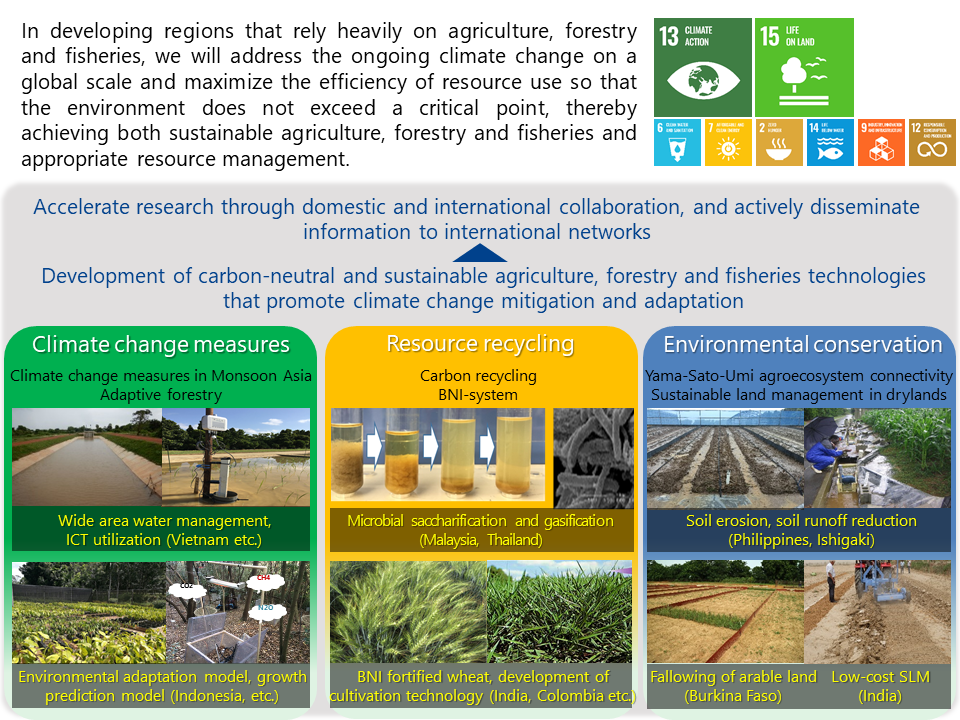Pick Up
349. Technology development for climate change measures, resource recycling and environmental protection〜The Environment Program

In October 2020, the so-called "carbon neutral" challenge has begun in Japan when it announced its intention to move toward a decarbonized society, aiming for zero greenhouse gas (GHG) emissions by 2050. In May 2021, the Ministry of Agriculture, Forestry and Fisheries formulated the "Green Food System Strategy" to actively contribute to this effort. To achieve carbon neutrality, it is important to reduce GHG emissions from agricultural production. Accelerated GHG emissions through crop cultivation, livestock production, and extractive forest resource use can amplify the burden on people's lives and society. Many farmers in developing regions that rely heavily on agriculture, forestry, and fisheries are small-scale farmers. Reduced production due to floods and droughts can threaten the daily livelihoods of their families. The increase in atmospheric concentrations of GHGs can directly and indirectly hurt people's lives. We need a carbon-neutral society in order to realize the 17 Sustainable Development Goals.
The Environment Program of JIRCAS aims to achieve the twin-goal of a sustainable agriculture, forestry, and fisheries sector and appropriate resource management by maximizing resource use efficiency in developing regions that are heavily dependent on agriculture, forestry, and fisheries. To achieve these, we will develop water management technologies that reduce GHG emissions, agricultural management technologies for livestock use, carbon recycling technologies that convert agricultural waste into resources, low-impact agricultural production systems that use biological nitrification control to reduce the environmental impact of nitrogen compounds, afforestation technologies that enhance the forestry productivity and environmental adaptability of tropical forests, and environmental conservation technologies through the yama-sato-umi agrosystem connectivity in the tropics and islands, soil conservation technology in arid regions, and technology to reduce the risk of drought. In the program, there are six projects that mainly contribute to SDG13 and SDG15.
(1) Development of comprehensive agricultural technologies for climate change mitigation and adaption in Monsoon Asia【Climate change measures in Monsoon Asia】
(2) Development of carbon recycling technologies to address global issues caused by agricultural waste【Carbon recycling】
(3) Development of planet-friendly agricultural production system using biological nitrification inhibition (BNI) technology 【BNI-system】
(4) Evaluation of genetic resources for strengthening productivity and adaptability of tropical forests【Adaptive forestry】
(5) Development and evaluation of environmental conservation technologies for tropical islands through an approach emphasizing Yama-Sato-Umi (Ridge-to-reef agroecosystem) connectivity【Yama-Sato-Umi agroecosystem connectivity】
(6) Development of sustainable land management technologies under extreme weather conditions in drylands【Sustainable land management in drylands】
References
- Pick Up 342. Overview of JIRCAS Research Programs https://www.jircas.go.jp/en/program/proc/blog/20210726
- Development of agricultural technologies for climate change, resource recycling and environmental conservationhttps://www.jircas.go.jp/ja/program/proa
- Development of comprehensive agricultural technologies for climate change mitigation and adaption in Monsoon Asia【Climate change measures in Monsoon Asia】https://www.jircas.go.jp/ja/program/proa/a1
- Development of carbon recycling technologies to address global issues caused by agricultural waste【Carbon recycling】https://www.jircas.go.jp/ja/program/proa/a2
- Development of planet-friendly agricultural production system using biological nitrification inhibition (BNI) technology 【BNI system】https://www.jircas.go.jp/ja/program/proa/a3
- Evaluation of genetic resources for strengthening productivity and adaptability of tropical forests【Adaptive forestry】https://www.jircas.go.jp/ja/program/proa/a4
- Development and evaluation of environmental conservation technologies for tropical islands through an approach emphasizing Yama-Sato-Umi (Ridge-to-reef agroecosystem) connectivity【 Yama-Sato-Umi agroecosystem connectivity】https://www.jircas.go.jp/ja/program/proa/a5
- Development of sustainable land management technologies under extreme weather conditions in drylands【sustainable land management in drylands】https://www.jircas.go.jp/ja/program/proa/a6
Contributor: HAYASHI Keiichi (Director, Environment Program)
